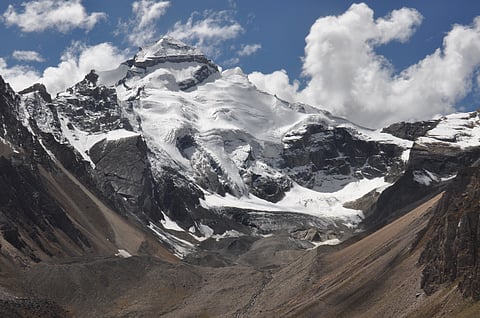
- Destinations
- Experiences
- Stay
- What's new
- Celebrating People
- Responsible Tourism
- CampaignsCampaigns
- SubscribeSubscribe
- Buy Now

One of India's most popular pilgrimage journeys, the Adi Kailash Yatra has commenced with the arrival of the first group of pilgrims at the Dharchula base camp in Uttarakhand. With more than 500 pilgrims from all over the country already committed to the yatra this year, this is a spiritual travel experience that should not be missed. This remarkable pilgrimage trek offers camps in stunning locations such as Pithoragarh, Dharchula, Gunji, Bundi, Chaukori, and Bhimtal. The current phase of the Adi Kailash yatra will continue through May and June. The yatra will remain closed during the monsoon months of July and August, and resume from September to November. The Uttarakhand Tourism Development Board (UTDB) had earlier launched India's inaugural helicopter yatra for Adi Kailash, and for Om Parvat.
Adi Kailash, a majestic peak nestled in the Himalayas within the Kumaon region of the Pithoragarh district in Uttarakhand, is part of the revered group of five sacred peaks known as the Panch Kailash. Often referred to as Shiva Kailash or Jonglingkong Peak, Adi Kailash holds great religious significance for both Hindus and Jains. It is believed to be the divine abode of Lord Shiva, akin to the revered Mount Kailash in Tibet. There are several sacred sites on this route. The base camp of the Adi Kailash trek is just 14 kilometers away from Kutti village. Along the journey, many trekkers make a stop to visit the sacred Gaurikund and pay their respects at the nearby Lord Shiva and Goddess Parvati Temple.
The Adi Kailash Yatra offers a captivating alternative to the renowned Kailash Mansarovar Yatra in Tibet. This spiritual journey takes travelers through breathtaking landscapes and sacred sites, providing an enriching experience. Covering a distance of around 150-200 kilometers, the journey offers diverse routes and unique experiences. One of the most popular routes starts from Dharchula town in Pithoragarh district. This 10-15 day trek showcases snow-covered peaks, picturesque valleys, and pristine lakes, while allowing immersion in local cultures and interaction with residents of remote villages.
It's important to carefully plan your yatra itinerary, considering the route and mode of transportation. You can start your journey from popular points like Kathgodam or Delhi and include key stops such as Pithoragarh, Dharchula, Gunji, and Nabi. These stops not only offer opportunities for rest and acclimatization but also provide a chance to explore nearby attractions. For the Adi Kailash Yatra, consider traveling with KMVN, as they offer a range of accommodations at all the points. Additionally, a recent development is the road network up to Jolingkong and Nabidhang, allowing travelers to drive up to that point in a suitable vehicle.
Only individuals aged 9 to 70 who are physically fit are eligible to participate in the pilgrimage. Therefore, it is important to ensure that you are in good physical condition before embarking on the journey, as it will involve trekking at high altitudes and challenging terrain. Prior to the trip, it is advisable to undergo a medical check-up to assess your fitness level and address any underlying health concerns. Additionally, you will need to obtain a medical certificate confirming that you are fit to undertake the trek along the mountainous route.
Embarking on this pilgrimage entails navigating challenging terrains and navigating high altitudes. Preparation for high-altitude trekking demands a holistic approach encompassing physical conditioning, mental resilience, and skill enhancement. Engaging in endurance training, strength training, and day hikes with a weighted pack will contribute to preparing the mind and body. Additionally, the significance of proper nutrition leading up to the trek cannot be overstated. Fueling the body with balanced whole foods and maintaining proper hydration will optimize training for best results.
Altitude Sickness Prevention
When embarking on a journey to a high-altitude location like the Adi Parvat route, it's crucial to understand the risks of altitude sickness, also known as acute mountain sickness (AMS). This condition can develop when ascending to high altitudes too rapidly, depriving the body of the necessary time to acclimate. Altitude sickness can impact individuals of all ages and fitness levels to varying degrees. The "climb high, sleep low" principle is a proven strategy for ascending to high-altitude destinations safely. This technique involves ascending to a higher altitude during the day and then descending to sleep at a lower altitude, effectively minimising the risk of altitude sickness.
Prepare for the unpredictable weather of the Himalayan region with layered clothing, starting with thermal underwear. Three thin layers are more effective than one thick layer. As the day warms up, you can remove layers down to an inner T-shirt or a fleece pullover. Don't forget to pack a good jacket, raingear, warm socks, gloves, and a woolen cap. Remember, 90% of body heat is lost through the head and feet. While there is accommodation along the route, it's wise to pack a sleeping bag and a sleeping mat for added comfort.
Get an Inner Line Permit from the local authorities or SDM office in Dharchula. Present a valid medical fitness certificate around 15 days before the commencement of the yatra. Carry a government-issued ID proof such as Aadhar card, passport, voter card, etc, at all times during the pilgrimage. Know more about documents required and how to register for the yatra here.
